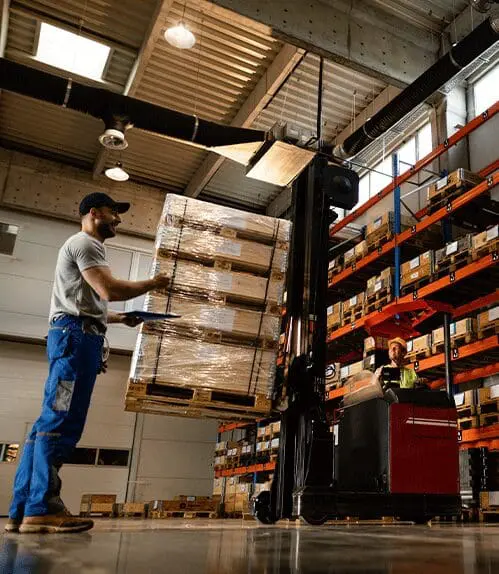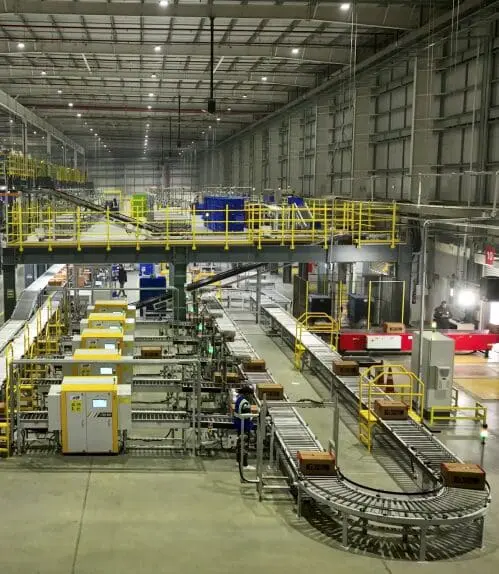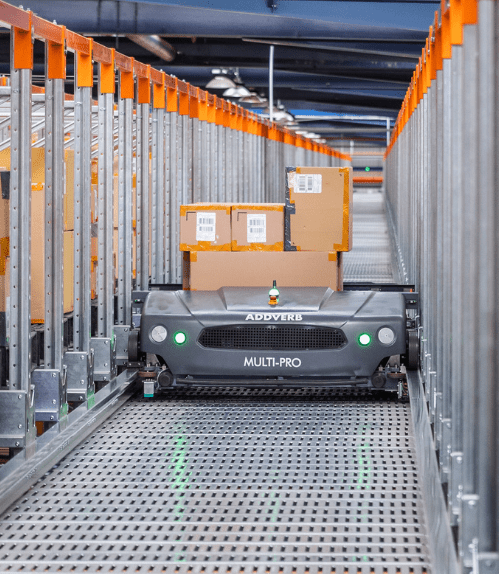Table of Contents
The rise of autonomous vehicles has sparked a revolution across multiple industries, with logistics and automated material handling standing out as key beneficiaries. As technology continues to advance, the demand for material handling systems is surging, driven by the need for enhanced efficiency, accuracy, and scalability.
In this blog, we will explore how autonomous vehicles are meeting these growing demands, the advantages they offer, and the long-term implications for industries worldwide.
Welcome to Reliance Sultanpur, where Addverb’s advanced automation solutions are transforming Warehouse Material Movement.
What is Automated Material Handling?
Automated warehouse material handling involves using automated systems and technologies to move, sort, manage, and store materials in manufacturing plants, warehouses, and distribution hubs. The main aim of AMH is to simplify complex logistical processes, reduce manual work, and significantly enhance efficiency and productivity. By automating these repetitive tasks, companies can focus on strategic growth while lowering the risk of human errors and workplace accidents.
The global Automated Material Handling market size is foreseen to grow from USD 33.3 billion in 2024 to USD 51.0 billion by 2029, at a CAGR of 8.9% from 2024 to 2029.
Source: Markets and Markets
The Evolution of Autonomous Vehicles
Over the past decade, autonomous vehicles have made remarkable strides. Thanks to the integration of advanced sensors, artificial intelligence (AI), and machine learning algorithms, these vehicles can now navigate complex environments, make real-time decisions, and operate independently. This groundbreaking technology is finding applications far beyond the automotive industry, with automated material movement and logistics emerging as critical impact areas.
Automation for Material Handling in Warehouses
Material handling involves the use of robotics and technology to perform tasks that human operators traditionally handle. This includes various activities such as transportation, sorting, stacking, and storage in warehouses, distribution centres, and manufacturing facilities. By leveraging autonomous vehicles, these material movement processes have become faster, more accurate, and increasingly efficient.
Advantages of Autonomous Vehicles in Automated Material Handling
Autonomous vehicles bring a host of benefits to material handling systems, transforming how industries operate:
Increased Productivity
Autonomous vehicles can operate around the clock without breaks or fatigue, significantly speeding up material handling processes. They navigate complex warehouse layouts with ease, optimize routes, and dynamically respond to changing conditions, leading to faster and more streamlined operations.
Enhanced Safety
By eliminating human error and reducing the need for manual intervention, autonomous vehicles greatly enhance safety in material handling tasks. Equipped with advanced collision detection and avoidance technologies, these vehicles minimize the risk of accidents and injuries, ensuring a safer working environment.
Scalability and Flexibility
Autonomous vehicles offer unparalleled scalability and flexibility. They can be seamlessly integrated into existing automated material handling systems, adapt to varying demands, and accommodate changes in product dimensions. This makes them ideal for handling a diverse range of SKUs, ensuring efficient operations even in dynamic environments.
Cost Savings
By reducing the reliance on physical labour, autonomous vehicles help companies achieve significant cost savings. Optimized routing and efficient resource use also lead to lower energy consumption, resulting in long-term financial benefits for material movement.
Data-Driven Insights
Autonomous vehicles generate vast amounts of data during operation. By harnessing this data, companies can monitor performance, conduct predictive maintenance, and optimize material handling processes, ultimately driving operational excellence, and improving overall efficiency.
Applications of Automated Material Handling
The versatility of autonomous vehicles is evident in their diverse applications within material handling systems:
Autonomous Mobile Robots (AMRs)
AMRs are compact robots designed to autonomously navigate warehouse environments, performing tasks such as order picking, inventory management, and product transportation. These robots seamlessly integrate with existing systems and interact with human operators, boosting overall efficiency in automated material handling.
ALSO READ: Autonomous Mobile Robots (AMR) – A Complete Guide
Automated Guided Vehicles (AGVs)
AGVs have been a staple in industries for years, autonomously transporting materials and following predefined routes. With their advanced capabilities, AGVs can now communicate with loading and unloading stations, delivering goods with precision and reliability in automated material handling.
Drones and Unmanned Aerial Vehicles (UAVs)
In certain warehouse settings, drones and UAVs are used for inventory management, security monitoring, and maintenance tasks. These aerial vehicles offer quick and efficient monitoring of large areas, reducing the need for physical labour and speeding up automated material handling processes.
Self-Driving Forklifts
Autonomous forklifts are revolutionising automated material movement in warehouses by safely transporting goods, navigating warehouses, and handling pallets with precision. These vehicles optimize space utilization, reduce product damage, and enhance productivity in storage facilities.
Innovative Solutions by Addverb
Addverb Technologies is at the forefront of developing cutting-edge solutions to meet the rising demands of various industries, leveraging advanced technologies such as LiDAR sensors, computer vision, and mapping systems. Here are some of their standout products designed for material handling:
Dynamo Autonomous Mobile Robot
Dynamo is a highly efficient robotic solution for automated material handling and goods transportation in warehouses and industrial settings. Equipped with LiDAR sensors, it offers precise obstacle detection, ensuring safe navigation without human intervention. The integration of computer vision allows Dynamo to adapt to changing environments, while its mapping technologies enable efficient route planning. By automating material delivery, Dynamo reduces manual labour and significantly boosts overall efficiency in automated material movement.
Veloce Multi-Carton Picking Robot
Veloce is an innovative mobile robot designed for cartons, crates, and case handling without the need for additional storage infrastructure. Utilizing a grid-based navigation path, veloce enables multiple robots to work in coordination, optimizing the storage and picking of case and carton loads. This versatile solution enhances the material handling process in warehouses and distribution centres, offering a cost-effective alternative to traditional storage methods.
Zippy High-Speed Sortation Robot
Zippy is a cutting-edge sortation robot designed to meet the growing demand for efficient sorting processes. Using ground markers with a grid pattern, Zippy excels in detecting and avoiding obstacles, enabling rapid SKU-wise sortation. This intelligent approach allows Zippy to adapt to demand fluctuations, streamline operations, and ensure cost efficiency. By automating the sorting process, Zippy enhances throughput and accuracy, driving customer satisfaction in automated material handling.
ALSO READ: Sorting Robot: The Sortation Solution for Businesses
Future of Material Handling and Logistics
Autonomous vehicles are set to become a cornerstone of material handling and logistics, offering unprecedented efficiency, safety, scalability, and cost savings. As technology continues to evolve and overcome challenges, these vehicles will play a pivotal role in shaping the future of industries, revolutionizing operations, and setting new standards for logistics excellence.
FAQ
What is Automated Material Handling (AMH)?
Automated Material Handling (AMH) refers to the use of automated systems and equipment to transport, sort, store, and manage materials in warehouses, manufacturing plants, and distribution centers to enhance operational efficiency.
What are the main advantages of AMH systems?
AMH systems reduce labor costs, improve productivity, enhance accuracy, streamline workflows, and minimize the risk of human errors and workplace injuries.
What types of equipment are used in Automated Material Handling?
AMH equipment includes conveyor systems, Automated Guided Vehicles (AGVs), Autonomous Mobile Robots (AMRs), Automated Storage and Retrieval Systems (ASRS), and robotic arms.
In which industries are AMH systems commonly used?
AMH systems are widely used in industries like manufacturing, warehousing, e-commerce, retail, automotive, and logistics to improve material handling and operational efficiency.
How do AMH systems improve warehouse productivity?
AMH systems automate repetitive tasks, reduce manual intervention, optimize storage space, and improve the speed and accuracy of material handling processes, leading to higher productivity.
Are AMH systems scalable for growing businesses?
Yes, AMH systems are highly scalable, allowing businesses to expand their operations and adapt to changing needs without significant disruptions to workflow.
Founded in 2016, Addverb offers complete robotics solutions for warehouse and industrial automation, with a strong global presence through its subsidiaries worldwide. The company provides a range of in-house automation products, including Autonomous Mobile Robots, ASRS, and sorting technologies. It serves over 350+ clients, including well-known companies such as Coca-Cola, Amazon, and DHL.






